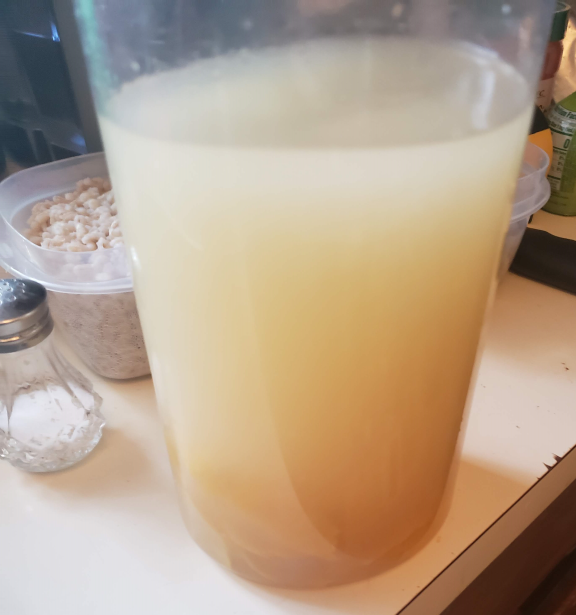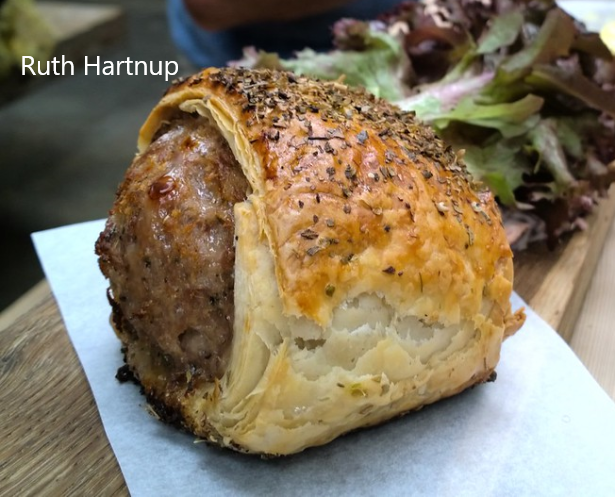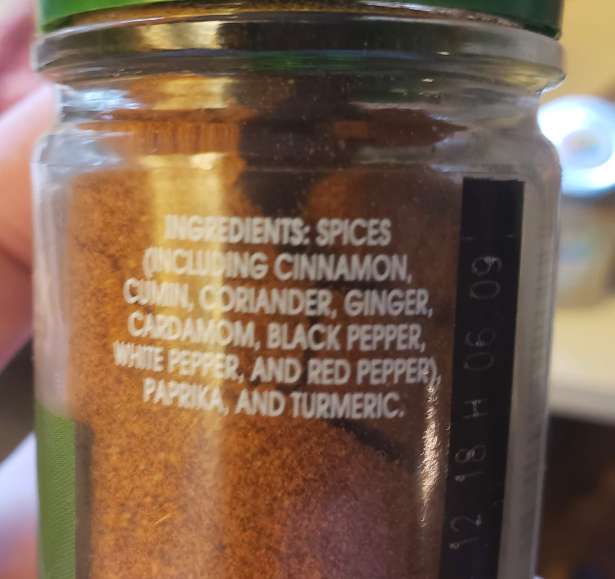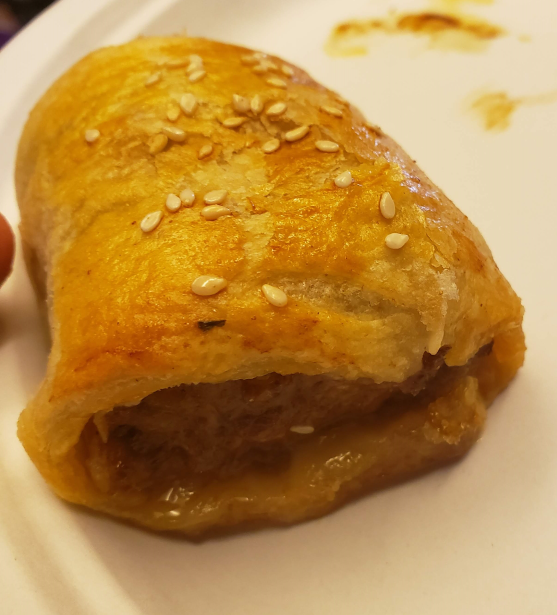KC 229 – Barley Water and Faux-Roccan Sausage Rolls

Why hello there, and welcome back to Kitchen Catastrophes, where one man’s saga of succulent strategies seizes souls and sparks salivation. I’m your Saucy Skald, Jon O’Guin, and today’s post is a doubled one, as I really wanted to protect myself from accusations of being “lazy”. Why? Well, I’ll be happy to explain, but if you just want to get straight to the specs, here’s a link to the recipes. Everyone else, let’s talk sausage rolls and summer squashes (not those ones)
Water? I Barley Know ‘Er!
So, originally, this post was going to just be about Barley Water. Barley Water, for my American readers, is…well, damn near what it says on the tin. It’s water…with barley. Specifically, it’s a beverage made of water filled with sugar, flavoring, and the residue or (more often, commercially) a powder derived from barley.
I am assured that this is a field of Barley, but honestly, all grains look fairly alike to me.
If that sounds weird to you, maybe this will make it make more sense: Barley water is BASICALLY old-school Gatorade, OR, you could think of it as “the Ovaltine of Fruit Juices”: just as Ovaltine/chocolate malt is the same basic flavors of hot chocolate/chocolate milk, just fortified with processed grain nutrients, so is Barley Water to like, Lemonade.
See, when you boil barley in water, it leaches out minerals, vitamins, and some starches into the cooking water. People eventually realized that this water was really useful for giving to children, or the sick, because it gave them things they needed in an easy-to-consume form, and it was popular in several hot or arid regions as a beverage for replenishing electrolytes, long before people really knew what those were. Add a little sugar and some fruit juice to make it a little tastier, and BOOM, you got a hit.
Now, the drink is consumed in many different nations, but the connection I have to it is via the UK. Because whenever I go shopping in the grocery store, I try to get at least one thing I’ve not gotten before, so I’m always pushing my culinary boundaries. It’s a strategy that confused and irritated several of my family members. Well, one day about 2 years ago, I was in Central Market, standing in the British food section, and decided to try this weird container.
Actually, the first one I picked was Lemon flavored, which is why today’s recipe is for Lemon. I just happened to pick up Orange on my latest trip.
The container turned out to be a bottle of CONCENTRATE, (called a “squash” or “cordial”, referring to typically fruit-flavored liquid you dilute to make a beverage. Hence my joke about summer squashes back at the beginning.) which I discovered after trying to drink some of it straight. Not a great experience, but once you mix some of the liquid with 4 parts water, you’ve got something that’s basically like a more refined/natural tasting Gatorade-esque experience. Like the kind of lemonade you’d expect to get at a health spa, where it doesn’t taste like normal lemonade, because you know they’ve ‘healthed it up’ somehow.
Since that discovery, I’ve actually become quite fond of the stuff. It was easy to whip up, tasted fine, and It supposedly has a lot of health benefits (supposedly fighting UTIs and Kidney stones, lowering blood pressure, and like, SIX other things). And, I discovered via Alton Brown’s cookbook, it’s really easy to make.
As you can guess from the cookbook title, this wasn’t a document for difficult options.
So I was certain I was going to make it. And I REMAINED certain of that for quite some time. The problem was: I had no REASON to make it. See, while the recipe IS stupidly easy, it’s also just a LITTLE too long, at about 45 minutes. And at first, I didn’t want to ruin the kind of special nature of the drink: We hit up Central Market normally once every 3 months or so, on our way back from Finnriver, where we’re Cider Club members, and have to pick up our club order. So every 3 months, I’d get a bottle that could make roughly a gallon of barley water, and I’d pick and choose when to make another glass or pitcher of it. Then, last summer, they re-organized my local Fred Meyer’s, and THEY started carrying it too! So while I knew I was going to, I ALSO knew deep down I wasn’t going to do it until/unless I needed to.
And that turned out to be a couple weeks ago. Fred Meyer went a couple weeks without stocking it, and while a 45 minute recipe is a bit irritating, a 70 minute DRIVE to go buy it was ridiculous. ALSO, it helped that I was reminded of the drink by a renewed connection with UK cuisine: Last month’s Universal Yums box was from the UK. (If you’ve forgotten, Universal Yums is a ‘box of the month’ style club devoted to international snacks, with each month targeting another country or region. We covered the France box back in March, and every month since then, we’ve covered the new Box of snacks (Brazil, Scandinavia, The Philippines, and now the UK) on our Patreon page, where anyone who gives us $1 a month or more can read them, a choice I made to force me to give our wonderful Patrons SOME kind of consistent Content. (The review of the UK box will be going up…probably this week, since the new box was shipped this morning.)
Anywho, the Box got me thinking: I should start doing a recipe every month that coincides with the country of the box, because A: it gives me an easy structure (I spend a LOT of time fiddling with what, exactly, to make for the site, and B: I can use it for a bonus monthly catastrophe for Patrons, or for a semi-natural monthly bump to REMIND people about the Patreon. Like, I hate writing those “check out our social media and Patreon” plugs at the end of posts, and have been happy to NOT do them for the past couple months due to everything going on…but I also got bills to pay, ya know? So if I just plug the site once per month in a natural way, BOOM, everybody wins. And then, I learned that this week is the PERFECT time to talk about Barley Water, because of the lack of Tennis!
Tennis: where love means nothing.
That sentence requires some explanation: it turns out that the last couple weeks SHOULD have been Wimbledon, the World Series of Tennis, maybe. (I do NOT know much about Tennis: basic rules, 5-6 players, a couple trivia details. I have no idea the relative importance of various tournaments.) And Robinson’s, the company that MAKES the Barley Waters I buy, have been a corporate partner at Wimbledon for EIGHTY years. It is a drink many Brits associate with the event, in the same way Americans think of, say, Hot dogs the Fourth of July.
The tournament was supposed to end yesterday, but, of course, was cancelled. Which means that Robinson’s Barley Water has lost a LOT of free advertising in the UK, so what better way to help them out then by plugging them in an American blog on how to make their product at home? (You know, now that I say it…probably a LOT of better ways.)
The Boiling Point
Now, this is a somewhat complicated process, so I want you to pay close attention. By which I mean “this is arguably easier than Kraft Mac and Cheese”. The first thing you’re going to do, is boil some barley in water.
I THOUGHT I took a picture of the dry bag, but apparently I dd it with the rinsed grains in my wet hand. Which is weird timing, but whatever.
Specifically, get a cup of pearl barley (barley that’s already had its hull, an outer protective coating, removed), and 10 cups of water, and bring it to a boil. (you need a LOT of water here, because the barley’s going to absorb like, 3 cups of it, and you want enough left over liquid to make about 2 quarts) Then, reduce the heat to medium, and let it boil for 30 minutes.
That’s the long part: are you ready for the hard part? Juice and peel 2 lemons into a 2+ quart pitcher.
Or peel them, put the peels in the pitcher, and then juice into the pitcher.
Once the peels and juice are in, add about a half cup of honey, or a commensurate amount of the sweetener of your choice. Congratulations, you’ve assembled all the ingredients. Really, the only thing that could go wrong is if you forget that boiling grains to fill the water with starches and proteins is going to naturally cause the bubbles to have greater holding power, allowing your pot to fill up and bubble trails of starch-laden water down the sides of your pot because you didn’t lower the temperature fast enough.
The only thing. Hypothetically.
And…In 30 minutes, let the water and barley cool for a couple minutes, and then just pour the hot barley water through a strainer into the pitcher with the lemon juice and sweetener (the strainer is to catch rogue barley so your drink isn’t chewy later). Stir to dissolve the sweetener, use the barley for…something else, I don’t know, and you’re done!
Murky success!
You CAN drink it hot, or you can let it cool in the fridge before serving. I will say that the homemade version is a little ‘higher’ than the store-bought: a little more acidic and a little less sweet, with a milkier look to it. Personally, I prefer the store-bought version a little, but I bet with a little tinkering, I could get the home-made to a place where I might prefer it.
Now, here’s the twist: I made TWO recipes this week, because I’m kind of dumb.
On A Roll
Now, in my defense, you have to understand that, again: I don’t really care about Tennis. So I didn’t KNOW that I had actually made my batch at the start of when the tournament was supposed to happen, or that I was in the middle of the perfect window to put out the recipe. Instead, I was looking around, asking “Can I justify putting out a post that’s 3 steps long without much of a history?” I knew vaguely that Barley water was served at Wimbledon, not that it was a big deal. It wasn’t until Sunday morning, watching the new SortedFood video, where they announced “it’s Wimbledon!” that I realized I already had a great tie-in.
Which is a pity, because I spent all week working to make ANOTHER British recipe, to keep you all from rioting because I gave you “lemonade with electrolytes” as a weekly post. SO NOW let’s talk about these Faux-roccan Lamb Sausage Rolls. First, let’s get everyone up to speed: what the hell’s a sausage roll?
A poor man’s beef wellington?
A Sausage Roll is a common English (well, Commonwealth) snack/meal option, consisting of pastry wrapped around sausage meat. It is a snack of quintessential cultural relevance that puts it roughly on par with Hot Dogs in America: Gregg’s, a popular bakery chain in the UK, sells 140 Sausage rolls a year. That’s an average of 2 rolls per person per year, from ONE bakery chain. Nowadays, the pastry is typically puff pastry, but it used to be pie-pastry, though some histories suggest it was originally puff pastry, with some believing the first sausage rolls were meat-filled croissants.
I felt it was a great recipe to pair with the Barley water because it is similarly insanely easy: It’s literally just “sausage meat wrapped in pastry dough”. If you buy pre-made dough and sausage meat, your job is just rolling, cutting, and roasting. We go ONE step farther, by making the sausage mixture ourselves.
Now, this recipe is definitely intended to invoke to the British consumer the ideas and flavors of Morocco, a relatively popular/linked culture to the UK, due to the whole “owning the Strait of Gibraltar” thing. (Actually, the two have had a relatively close and positive relationship for centuries). So the recipe uses ground Lamb, and uses some popular Moroccan spices (Which we’ll get into in a minute), and it also calls for two specific Moroccan ingredients, one that I had on hand, and one that led me on a merry chase.
The first is harissa, the spice paste, which I continue to buy despite rarely using, and the SECOND is this swollen boy.
But how do they get the Lemon tree into the bottle?
THAT is a preserved lemon: it’s a relatively common ingredient in Mediterranean cooking: you take whole lemons, clean them, and then either cut them open and cover them with salt, pressing to fill the jar with a brine of lemon juice and salt…or you pop them into the jar whole, and cover them with a brine of lemon juice and salt. (You can also add other spices/flavorings to the brine, but most recipes I’ve seen call for nothing more than lemons, salt, and maybe additional lemon juice) After a couple weeks in the brine, the lemon peel will become slightly translucent, and they’re ready to use. (The peel, at least: most recipes ALSO want nothing to do with the flesh of the lemon after the curing is complete: you’re really just making preserved lemon RIND) They taste…like a mildly better version of exactly what you’d expect: they’re salty, sour, a bitter element…but also quite citrus-y. They show up in a lot of stews in the region. Here, you’re dicing up the peel of one of them, and mixing it into the sausage.
Next, you’re combining some Cinnamon, ground ginger, cumin, and…why does this sound familiar?
Almost as if I’ve read it before.
Oh, yeah, you’re just making a poor man’s Ras Al Hanout. Well, I HAVE Ras Al Hanout, so I’m just going to use that instead of most of the spices they suggest.
They also call for chopped Coriander, which is NOT a spice, but rather an herb, since in the UK, they don’t make a distinction between the seed and the leaf of a specific plant, which we do in America. That plant is Coriander, or, as you might call the leaves: Cilantro. (This is because the leaves of the plant are more popular in Mexican cooking than most American cooking, and Cilantro is the SPANISH word for “coriander”, while we continually used the seeds, thanks to the Spice trade. So most Americans aren’t even aware that it’s the same plant.) And it’s an ingredient I used VERY carefully in the recipe, since, as we’ve noted before, my brother Nate is one of those people for whom “cilantro” tastes like soap. It’s mostly the fresh compounds for him (coriander seeds don’t bother him too much), so I tried using dried leaves, and replacing some of them with thyme.
Thinking about it, it’s kind of weird we even HAVE this.
Mash the meat, the spices, the lemon, and, unlike me, DON’T forget the Harissa (Which is amazing, because the official name of this recipe from my source, BBC GoodFood, is “Harissa and Lamb sausage Rolls”. I almost forgot the FIRST THING you learn about the recipe).
You also want to roll out some pastry dough: do yourself a favor and check how much you have to roll out each way BEFORE you start. I, in the reverse move to most men, mistook 8 inches for 6, and rolled my first half of the pastry dough too wide and not quite long enough, forcing half my sausage rolls to be a little fatter than they should be.
They’re the ones on the right, and you can definitely see the difference.
But the second half actually worked like a dream. And once you have the sausage sealed in the dough, cut it into chunks, give it an egg wash, and bake it for 20ish minutes, at “a temp”. And if that sounds unhelpfully vague, that’s because I somehow fucked up my math, and overcooked mine. Like I said, the recipe was from the BBC, so all the numbers were in Metric, and I goofed the conversion of Celsius to Fahrenheit. (I did: ‘Celsius times 1.8 then plus 32 is Fahrenheit, 200C times 1.8 is 380, plus 32 is…412? Great, I guess I get to figure out if 400 for longer is better, or 425 for shorter is…when 1.8 times 200 is 360, for a final number of 392. So I was cooking 20 degrees HOTTER than I should have. (actually, I choose the 425 for shorter, so I was 33 degrees hotter) Which, knowing that…really explains a lot about how they turned out.
BEHOLD my disgusting, absolutely normal-looking results.
These guys weren’t terrible. What they WERE was a little off, texture wise, with a lot of rendered lamb grease coming out of them. Like, imagine a meatball sub, where the meatballs are a little too firm, and the bread a little too soft. That’s the texture we had. Not terrible, but a little off-putting. And personally, I felt that the sausage itself was impressively unimpressive: despite being a mix of lamb, lemon peel, spice paste, and spice blend, the result tastes kind of generically ‘warm’. Nate had similar thoughts: flavors weren’t exactly his favorite, but they were fine, the biggest problem was the grease. And that’s probably because the higher heat rendered out more fat, or because we under-worked the mixture, so that’s likely user error.
Still, they were edible, and functional. With a couple flavoring tweaks, I’m sure I can make a sausage roll that’s a delight for Nate and I. And between them and the Barley Water, I think we had two perfectly adequate results that can be expanded to personal taste. I feel like I should make some kind of Tennis pun here. But I’ve got Love.
THURSDAY: DUNNO. I DEBATED PUSHING BACK THE SAUSAGE ROLL, BUT I DIDN’T, SO NOW I’M HERE.
MONDAY: EGGS, PROBABLY. OR SLOPPY JOES. BOTH OF WHICH WERE GOOD.
Here's the
Recipes
Barley Water with Lemon
Makes a little under 2 quarts
Ingredients
1 cup pearl barley
10 cups water
2 Lemons
¼ cup of honey or other sweetener.
Preparation
Put the barley and water in a large pot, and bring to a boil over high heat. Reduce the heat to medium-low and simmer for 30 minutes.
While barley simmers, peel the two lemons, avoiding the bitter white pith, and place the peels into a 2 quart pitcher. Juice the two lemons (catching any seeds or pulp) into the pitcher as well. Add honey.
Once the barley has cooked for 30 minutes, remove from the heat, and let cool for 5 minutes before pouring the water into the pitcher through a fine-mesh strainer to catch the barley. Set barley aside, stir to dissolve the honey, and drink hot or let cool.
Faux-roccan Sausage Rolls
Makes 8 sausage rolls
Ingredients
Sausage
600g lamb mince (roughly 1 1/3rd pound)
2 tbsp shop-bought harissa
¼ tsp ground ginger
1 tsp ras al hanout (replace with a mixture of cinnamon, cumin, and pepper/paprika if unavailable)
2 tbsp chopped cilantro (or 2 tsp dried)
2 garlic cloves, grated
1 preserved lemon, rind finely chopped (discard the flesh)
Roll
All-Purpose flour, for dusting
1 sheet ready rolled puff pastry (thawed)
1 large egg, lightly beaten
2 tsp sesame seeds (optional)
Preparation
Preheat your oven to 400 degrees Fahrenheit. In a large bowl, mix together all the ingredients of the sausage until thoroughly incorporated.
Unfold the sheet of puff pastry, and cut in half lengthwise. Cover one half with paper towels while you work on the first. Roll the first half out to around 6” by 16”. (This will mostly be rolling LONGER, not a lot of ‘wider’). Take ¼ of the sausage and roll to around 8 inches in length. Place on one half of the rolled-out pastry dough. Taken another ¼, and repeat with the other half. Brush one edge with the beaten egg, and wrap the sausage with the pastry, and cut into 4 equal pieces. Repeat rolling, filling, and cutting with the other half of the pastry, and sausage.
Place cut rolls onto a baking sheet, brush with the rest of the beaten egg (this will make them brown better), and sprinkle with some sesame seeds, if desired. Bake for 20-25 minutes.



















